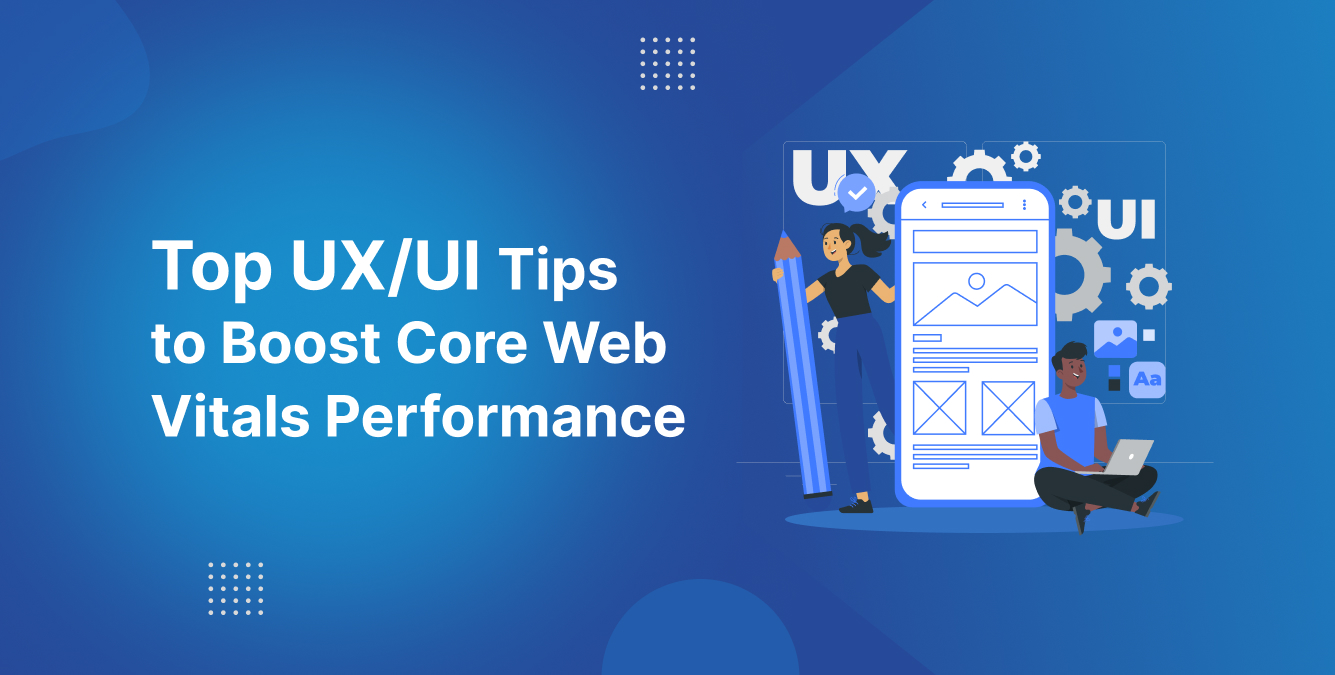Top UX/UI Tips to Boost Core Web Vitals Performance



Introduction
As people expect websites to load faster and work more smoothly, having a quick, stable, and responsive site is more important than ever. One of the key ways to make this happen is by focusing on Core Web Vitals—a set of performance metrics from Google that measure how users actually experience a website. These metrics now play a big role in how websites rank in search results, so it’s important for designers, developers, and marketers to pay attention.
Most people try to fix performance by working on server speed or backend improvements. But one of the most effective—and often overlooked—areas is UX/UI design. A well-designed user interface and experience can greatly improve Core Web Vitals, lower bounce rates, and keep users happy. In this blog, we’ll look at simple, practical UX/UI tips that follow Core Web Vitals best practices—the same strategies trusted by today’s top digital marketing agencies to improve SEO, usability, and overall site performance.
What Are Core Web Vitals? (A Quick Refresher)
Before diving into design tips, let’s quickly define Core Web Vitals. These are three essential performance metrics tracked by Google:
- Largest Contentful Paint (LCP): Measures how fast the largest visible element on a page loads. Target: under 2.5 seconds.
- Interaction to Next Paint (INP): Formerly FID, this measures input responsiveness and interaction latency. Target: under 200 milliseconds.
- Cumulative Layout Shift (CLS): Measures visual stability—how much elements move around as the page loads. Target: below 0.1.
Together, these metrics indicate whether users experience a smooth, fast, and reliable site. You can check Core Web Vitals using tools like Google PageSpeed Insights, Lighthouse, or Search Console.
The Link Between UX/UI Design and Google Core Web Vitals
Good design isn’t just aesthetic—it’s functional. The choices made in UX/UI design directly influence how a site loads and feels:
- A bloated hero image affects LCP.
- Poorly implemented buttons or heavy JavaScript can delay interaction, harming INP.
- A navigation bar that jumps while loading fonts contributes to a poor CLS score.
These issues demonstrate the need for designers and developers to work together and focus on a shared goal: optimizing both visuals and performance.
Top UX/UI Tips to Improve Core Web Vitals Metrics
1. Optimize Visual Load Order (Boosting LCP)
Visual hierarchy plays a key role in how quickly users perceive a page to load. Here’s how to optimize LCP through design:
- Prioritize Above-the-Fold Content: Ensure the main content—usually headings, banners, and featured images—loads first.
- Avoid Full-Screen Hero Images: They can delay LCP. Instead, use lightweight visuals or CSS-based backgrounds.
- Implement Lazy Loading Smartly: Load off-screen images as users scroll. But avoid lazy-loading above-the-fold assets.
- Use Performance-Optimized Image Formats: WebP and AVIF can significantly reduce image sizes without loss of quality.
2. Streamline Interactivity (Reducing INP)
Slow input response often stems from heavy UI interactions or inefficient event handling:
- Avoid Overusing JavaScript Frameworks: Keep interactivity lean. Overly complex buttons or sliders can delay responses.
- Use Native HTML Elements: Browser-optimized inputs and buttons perform better than custom-styled ones.
- Minimize Third-Party Scripts: Excessive scripts block the main thread and delay interactions.
- Use Loading Indicators or Skeleton Screens: These give feedback while content is loading and reduce perceived delays.
3. Prevent Layout Shifts (Improving CLS)
Unstable layouts break trust and ruin the user experience. Common design practices can reduce CLS:
- Reserve Space for Media and Ads: Always define image and video dimensions in CSS or HTML.
- Preload Fonts: Fonts often cause layout shifts if they load late. Use font-display: swap and preload key assets.
- Avoid DOM Insertions Above Fold: Dynamic banners or carousels that push content down contribute to poor CLS.
- Avoid Unpredictable UI Components: Minimize accordions, dropdowns, or animations that appear without user intent.
UI/UX Design Best Practices for Core Web Vitals
Mobile-First Design with Fast Tap Targets
With mobile-first indexing and rising smartphone usage, optimizing UX/UI for smaller screens is essential:
- Ensure Buttons Are Large Enough to Tap: Maintain a minimum of 48×48 pixels.
- Avoid Crowded Interfaces: Leave enough spacing between clickable elements to avoid accidental taps.
- Disable Unnecessary Animations on Mobile: They add weight and can disrupt layout stability.
Consistency in Design Systems
Design consistency isn’t just aesthetic—it improves performance:
- Reuse UI Components: Component libraries ensure consistent behavior and reduce CSS duplication.
- Avoid Overusing Custom Fonts or Icons: Stick to 1–2 typefaces and use SVGs over icon libraries.
Typography and Font Loading
Fonts are often overlooked when you try to optimize for Core Web Vitals:
- Use Font Display Swap: This prevents invisible text during load, improving visual stability.
- Self-host Fonts: Hosting fonts locally reduces latency compared to fetching from third-party sources.
- Limit Variants: Stick to essential weights to minimize font file size.
Minimalist Navigation and Content Layout
Cleaner designs lead to faster rendering and better comprehension:
- Use Simple Navigation Menus: Avoid multi-level dropdowns and mega menus unless absolutely necessary.
- Highlight One CTA Per Page: Reduces user confusion and decreases render time.
- Limit Content Blocks: Break content into digestible sections without overwhelming the layout.
Advanced UI Engineering Tips
Critical CSS & Above-the-Fold Prioritization
- Inline Critical CSS: Ensures the browser renders above-the-fold content immediately.
- Split CSS by Page Type: Load only the necessary styles for each page.
Use Native Elements Where Possible
- Reduce Over-Engineering: Native elements load faster and are more accessible.
- Avoid Custom Dropdowns or Buttons: They often rely on large JavaScript libraries.
Smart Component Lazy Loading
- Lazy Load Non-Essential Components: Comment sections, modals, or sliders that aren’t immediately visible.
- Preload Predictable Interactions: Use predictive loading for commonly clicked pages or features.
Design Collaboration Tips Between Developers and Designers
The effectiveness of any Core Web Vitals strategy relies heavily on collaboration between graphic design and development teams. Consider these best practices:
- Establish Shared Performance Goals: Define clear LCP, INP, and CLS targets early, ensuring both designers and developers are working toward the same performance benchmarks.
- Use Tools like Figma with Performance Annotations: Highlight critical design elements—such as hero images or CTAs—that should load first, making priorities visible to developers.
- Create a Core Web Vitals Checklist for Every Page: Use a standardized checklist during design reviews to ensure every page meets performance and usability standards before development begins.
This cross-functional alignment fosters better execution, fewer reworks, and more consistent delivery of fast, user-friendly digital experiences.
Common UX/UI Mistakes That Hurt Core Web Vitals
Avoiding common UX/UI pitfalls is crucial to maintaining strong Core Web Vitals. Here are practices to steer clear of:
- Overuse of Carousels and Sliders: These elements are often heavy on resources, contribute little to engagement, and delay initial load times.
- Unoptimized Pop-Ups and Modals: If not set to load conditionally, pop-ups can block rendering and push important content further down the load queue.
- Custom Scrollbars or Infinite Scrolling: These can interfere with native browser behavior, hinder accessibility, and create layout instability.
- Auto-Playing Videos with Sound: These not only increase LCP but also frustrate users, especially on mobile or slower connections.
By avoiding these visual design missteps, you help ensure a faster, more stable, and user-friendly experience.
How a Digital Marketing Agency Approaches This
Professional agencies view Core Web Vitals as part of a larger digital ecosystem, not isolated metrics. Their integrated approach includes:
- Performance-First UX/UI Design: Every visual and interactive element is crafted to support speed, responsiveness, and stability from the ground up.
- Regular Core Web Vitals Audits: Agencies use tools like Lighthouse and Search Console to continuously monitor, test, and refine performance across all key web pages.
- Design + SEO Alignment: By aligning design aesthetics with SEO strategy, agencies ensure that branding and performance go hand-in-hand for better rankings and user engagement.
This unified strategy not only helps fix Core Web Vitals issues but also establishes a solid, scalable foundation for consistent page performance, search visibility, and long-term business success.
How to Fix Core Web Vitals Issues Proactively
Waiting for issues to appear in Google Search Console is a reactive approach. To stay ahead, consider these proactive strategies:
- Conduct Regular UX Audits: Regularly assess user flows, navigation clarity, and interactive elements to identify performance blockers early.
- Leverage Real User Monitoring (RUM): Use tools like Chrome UX Report (CrUX) to gather live performance data from actual users across devices and locations.
- Integrate Performance Budgets in the Design Phase: Set specific limits on image sizes, script weights, and load times during the planning stage to ensure a performance-focused design.
By applying these proactive measures, your team can avoid costly rework and ensure your website consistently meets Core Web Vitals standards—creating a faster, more reliable experience from the ground up.
Tools to Check and Improve Core Web Vitals
Here are essential tools to help track and optimize performance:
- PageSpeed Insights: Google’s tool that shows LCP, INP, CLS with recommendations.
- Lighthouse: Run audits locally for in-depth analysis.
- WebPageTest: Advanced diagnostics and load time breakdowns.
- Chrome DevTools: Real-time Core Web Vitals in the Performance tab.
- Core Web Vitals Chrome Extension: View scores as you browse.
These tools help validate whether your UX/UI efforts are actually improving site metrics.
Conclusion
Improving your website’s Core Web Vitals isn’t just a technical task—it’s a design responsibility. UX/UI decisions made during wireframing, prototyping, and development play a pivotal role in how users experience speed, stability, and responsiveness.
By prioritizing visual hierarchy, reducing layout shifts, and designing for interactivity, you can elevate your site’s performance and user trust. If you’re struggling to implement these changes or need a comprehensive performance strategy, consider working with experienced professionals.
Hire Core Web Vitals experts to ensure your UX/UI aligns with best practices and Google’s performance benchmarks.
Frequently Asked Questions (FAQs)
It’s recommended to monitor Core Web Vitals monthly, especially after major design updates or content changes. Google Search Console offers automated tracking, and tools like PageSpeed Insights help with real-time diagnostics.
Yes, enhancing UI can significantly improve user engagement and Core Web Vitals metrics, both of which influence search rankings. However, UI improvements should be paired with technical SEO strategies for best results.
Mobile performance is a key part of Core Web Vitals since Google uses mobile-first indexing. Poor tap targets, slow interaction, and unstable layouts impact mobile vitals more than desktop versions.
Yes. As of 2025, Core Web Vitals continue to be part of the Page Experience update and influence how Google ranks pages. Good vitals scores can lead to better visibility in SERPs.
Optimizing above-the-fold content, using faster image formats, minimizing critical CSS, and leveraging server-side rendering can quickly enhance LCP metrics.